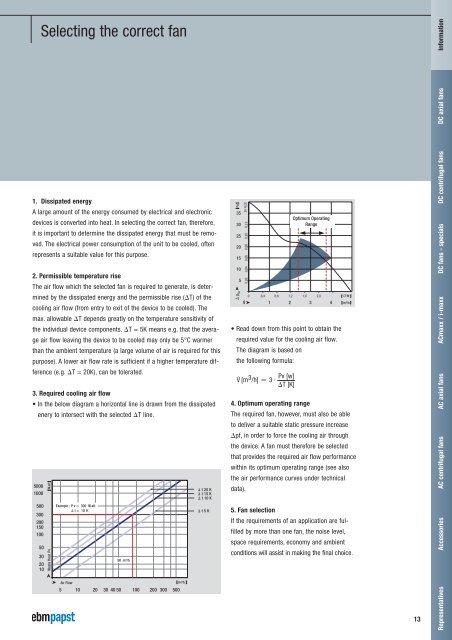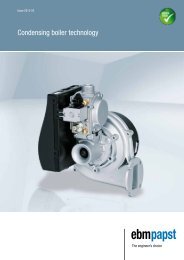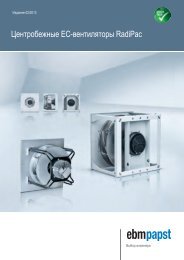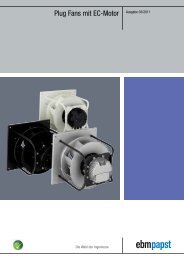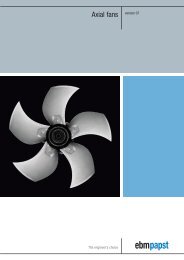Compact fans for AC and DC
Compact fans for AC and DC version 2011 - ebm-papst
Compact fans for AC and DC version 2011 - ebm-papst
- No tags were found...
You also want an ePaper? Increase the reach of your titles
YUMPU automatically turns print PDFs into web optimized ePapers that Google loves.
Selecting the correct fanIn<strong>for</strong>mation<strong>DC</strong> axial <strong>fans</strong>1. Dissipated energyA large amount of the energy consumed by electrical <strong>and</strong> electronicdevices is converted into heat. In selecting the correct fan, there<strong>for</strong>e,it is important to determine the dissipated energy that must be removed.The electrical power consumption of the unit to be cooled, oftenrepresents a suitable value <strong>for</strong> this purpose.2. Permissible temperature riseThe air flow which the selected fan is required to generate, is determinedby the dissipated energy <strong>and</strong> the permissible rise (∆T) of thecooling air flow (from entry to exit of the device to be cooled). Themax. allowable ∆T depends greatly on the temperature sensitivity ofthe individual device components. ∆T = 5K means e.g. that the averageair flow leaving the device to be cooled may only be 5°C warmerthan the ambient temperature (a large volume of air is required <strong>for</strong> thispurpose). A lower air flow rate is sufficient if a higher temperature difference(e.g. ∆T = 20K), can be tolerated.3. Required cooling air flow• In the below diagram a horizontal line is drawn from the dissipatedenery to intersect with the selected ∆T line.5000100050030020015010050302010Waste Heat Pv WattExample : P v = 300 W att∆ t = 10 K90 m³/hAir Flowm³/h5 10 20 30 40 50 100 200 300 500∆ t 20 K∆ t 15 K∆ t 10 K∆ t 5 KPa35302520151050,02 0,04 0,06 0,08 0,10 0,12 [in H 2 O]0• Read down from this point to obtain therequired value <strong>for</strong> the cooling air flow.The diagram is based onthe following <strong>for</strong>mula:V· [m 3 /h] ≈ 3 ·0,4 0,8 1,2 1,6 2,0CFM1 2 3 4 m³/hPv [w]∆T [K]Optimum OperatingRange4. Optimum operating rangeThe required fan, however, must also be ableto deliver a suitable static pressure increase∆pf, in order to <strong>for</strong>ce the cooling air throughthe device. A fan must there<strong>for</strong>e be selectedthat provides the required air flow per<strong>for</strong>mancewithin its optimum operating range (see alsothe air per<strong>for</strong>mance curves under technicaldata).5. Fan selectionIf the requirements of an application are fulfilledby more than one fan, the noise level,space requirements, economy <strong>and</strong> ambientconditions will assist in making the final choice.13Representatives Accessories <strong>AC</strong> centrifugal <strong>fans</strong> <strong>AC</strong> axial <strong>fans</strong> <strong>AC</strong>maxx / i-maxx <strong>DC</strong> <strong>fans</strong> - specials <strong>DC</strong> centrifugal <strong>fans</strong>


